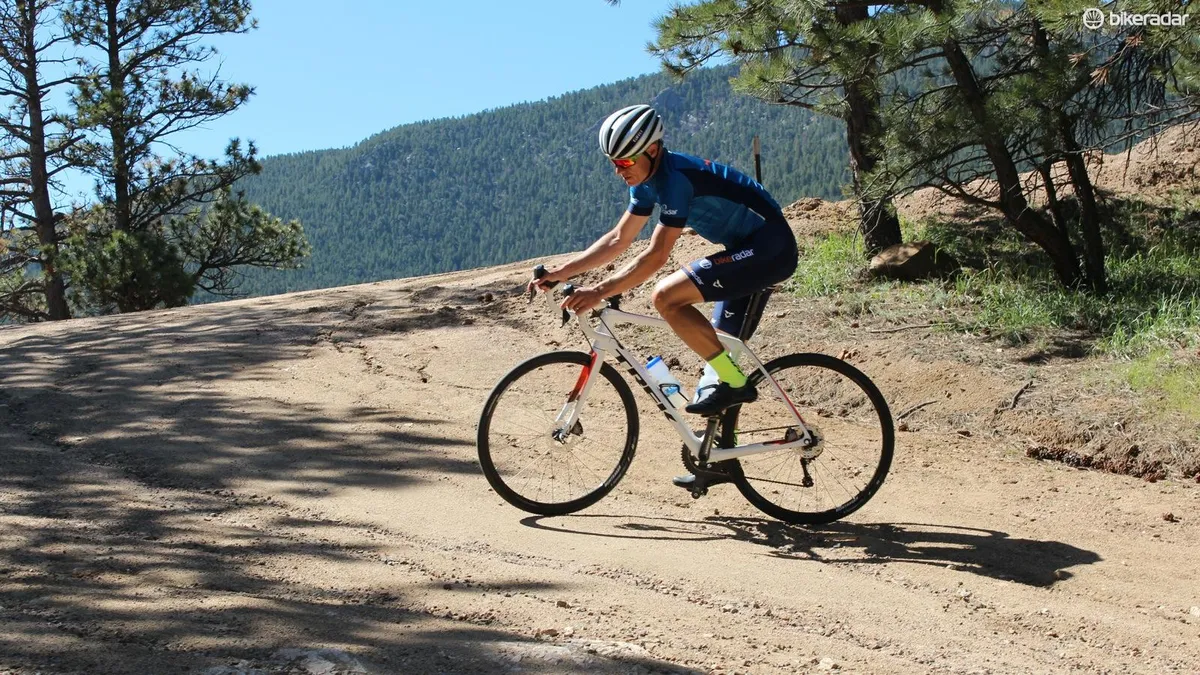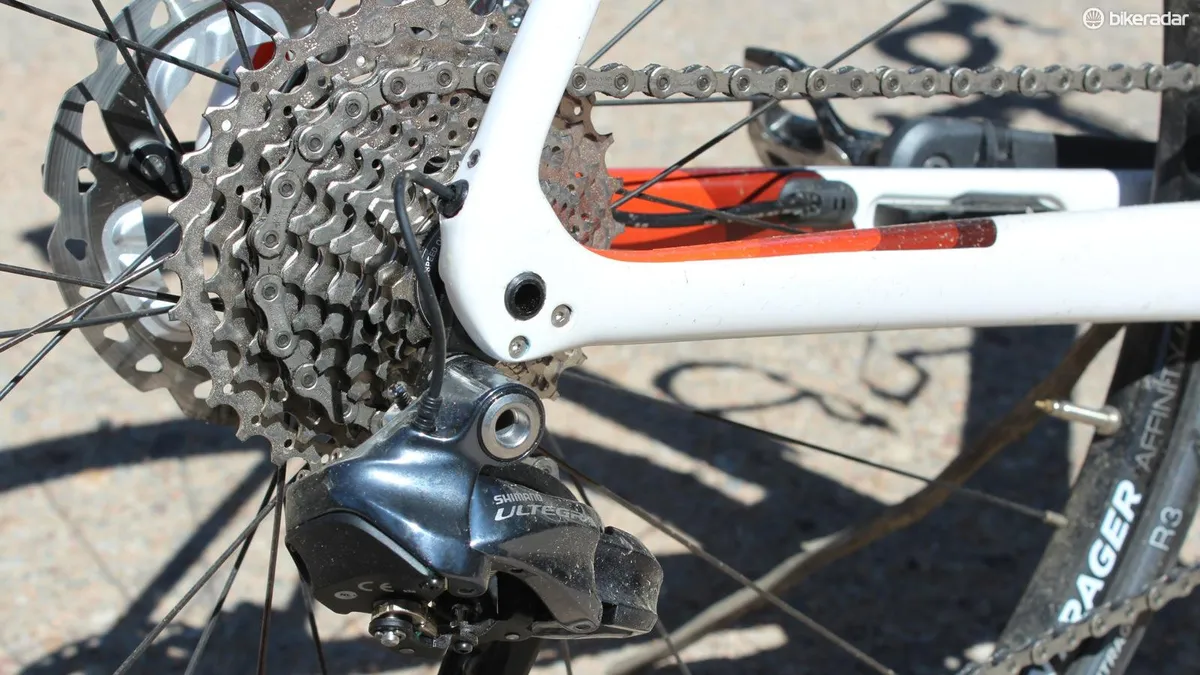With what is effectively a full-suspension frame, gargantuan clinchers on tubeless-ready wheels, and steady endurance geometry that isn’t skyscraper high on the front end, the new Trek Domane SLR 7 Disc is easily the best endurance road bike I’ve ridden.
- Here's Trek's new range of road bikes for 2017
- Trek Domane SLR 7 review
- 5 ways to improve your cycling endurance
In completely rethinking how the tubes of a frame brace each other, Trek engineers have redefined how a road bike interacts with the road and the rider.
With IsoSpeed pivots front and rear, Trek engineers have allowed the machine to flex for the much-sought-after vertical compliance in ways never achieved before.
Further, instead of pigeonholing the bike as an adventure bike or an endurance bike as is the trend, the Domane’s geometry and tire clearance are such that it can be both. Especially in this disc configuration that comes with 32mm clinchers and room for more, the Domane SLR is a well-mannered road bike that’s at home on pavement and dirt roads.
I enjoyed doing spirited group road rides on the Domane — even with the plump Bontrager clinchers at about 65psi — and also rallying it down washboard dirt descents.

The bike is no featherweight climber — and you can read about my clumsy experience on the 52,500ft / 16,000m Mavic Haute Route Rockies here — but that’s not the point of this machine. If you want a bike with steady manners that can easily handle some extracurricular detours down rough lanes and dirt backroads, then I can heartily recommend the Domane.
Rethinking frame design
Ever since the endurance road bike was created, engineers had a few levers they could pull to add comfort.
The biggest contributing factor to comfort in terms of the frameset comes at the seatpost, which can flex vertically precisely because there is no triangulated bracing
Wider tires — and the fork and frame clearance to handle them — are the most obvious and the most impactful variable when seeking to add comfort to a bike. Just ask the pros who race Paris-Roubaix every year.
Then there is the carbon layup in the fork and frame. One of the great things about the wonder material is that engineers can, to some degree, ‘tune’ how tubes act through the fiber orientation, tube shape and construction. Look at the flat chainstays on a Cannondale Synapse or the pencil-thin seatstays on a Cervélo R or C Series.
The former allows for some vertical flex while keeping pedaling stiffness, and the latter just allows for a bit of vertical flex to help take the edge of the bumps. The thing is, road bicycle frames are built in vertically oriented triangles, and this triangulation is at odds with the whole ‘laterally stiff yet vertically compliant’ thing.

The biggest contributing factor to comfort in terms of the frameset comes at the seatpost, which can flex vertically precisely because there is no triangulated bracing. Note the skinny 25.4 seatpost on the Synapse, for example; I would argue that this piece contributes far more to comfort than the split downtube.
The original Domane thumbed its nose at traditional double triangle design by adding a pivot where the seat tube is typically locked solidly into the top tube and seatstays. In doing so, the seatpost flex that used to stop at this junction now could extend all the way down to the bottom bracket. The resulting suspension was and is immediately apparent when riding.
For 2016, this pivot, which Trek calls an IsoSpeed Decoupler, was added to the front end, as well. The concept is the same as at the rear — let the carbon flex more vertically with fore and aft movement while restricting side-to-side movement.

Normally, a bike’s front end will flex at the fork’s legs, and then a very small amount where the steerer tube protrudes above the top headset cap, plus a bit in the handlebar and stem.
By adding a pivot in the head tube, Trek engineers allowed a much longer section of the steerer tube to flex. Since it’s anchored on either side, there is no lateral play in the steerer, so it feels like a normal bike when you are steering, climbing or cornering.
Trek also added adjustability to the rear of the Domane SLR. By loosening a bolt that doubles as the lower water bottle cage bolt, you can then move a slider up and down on the seat tube. Moving it up stiffens the ride by effectively shortening the section of tube that is flexing. Moving it down softens the ride. I slammed that sucker all the way down and left it there.

How it feels to ride the Domane SLR
A common complaint on the original Domane was that it felt imbalanced; the back end was nice and soft but the front was relatively harsh. This new frameset is much more balanced. Bumps still come up through the frame, to be sure, but the harsh edges are smoothed off, front and rear.
The worse the roads get, the better the bike shines. On normal roads the Domane SLR feels like any other good endurance race bike. When you stand up and torque on the bars it certainly doesn’t feel mushy or soft; quite the opposite. The massive downtube and stubborn chainstays, anchored in the substantial 90mm bottom bracket shell, provide a solid pedaling platform.
But when seated you can pedal easily through choppy washboard. The low bottom bracket, raked-out fork, fat tires and front IsoSpeed make the Domane feel like you couldn’t dump it over if you tried.

While I still wish you could adjust the contact point of the Shimano hydraulic levers as easily as you can on rim brakes, the overall performance is best in class. Easy modulation, always-consistent power, and no need to fuss with it.
For me, being a fairly traditional roadie that likes to ride dirt as well as smooth pavement, I think Trek has absolutely nailed it with this bike
Similarly, Di2 remains the gold standard for electronic shifting, with five options of shift speed, auto trim on the front derailleur to match the rear shifts, and the impossibility of dirt, rain or mud affecting shifts. Of course, you do have to be smart enough to charge the thing…
With a compact crank (50/34) and a massive 11-32 cassette, you needn’t fear the hills.
How the Domane SLR fits
There are two fit options for the Domane family: Trek’s Endurance Geometry for the Disc bikes and a new Race Shop Limited Pro Endurance Geometry that you can get for the rim-brake version. With the latter, you can get a very aggressive, low position just like you can on an Emonda race bike, but with a longer wheelbase and a lower bottom bracket. The stack on a 56cm, for instance, is a scant 54cm.
On the Pro Endurance rim bike I tested in Belgium this spring, I had my normal 10cm of saddle-to-handlebar drop — and still had 3cm of spacers under the stem.

On this Domane SLR 7 Disc with Endurance Geometry, which has a 59.1cm stack, I replaced the tall top spacer with a shorter one, swapped in a 120mm -10 stem and was basically at my standard position. You can see the full geometry chart here.
The Domane SLR is not an out-and-out gravel bike. It’s not a super slack, ultra long, sleepy bike. It’s an endurance road bike that you can happily pilot wherever you like. For me, being a fairly traditional roadie that likes to ride dirt as well as smooth pavement, I think Trek has absolutely nailed it with this bike. I can get my familiar, race-like position on a stable bike that takes big, fat tires; usually it’s one or the other.
Bottom line: IsoSpeed + 32s = Plush, plush, plush
IsoSpeed isn’t magic, and it’s not air- or oil-damped suspension. But it isn’t a gimmick, either. Instead of bolting things onto a road frame’s traditional triangles like Specialized’s Zertz or even the elastomer suspension of the Pinarello K8-S, the Domane SLR reworks the configuration entirely, allowing carbon do its thing, flexing like an airplane wing in one direction and remaining stiff in the other.

In addition to being able to tune the frame, you can also tune the ride considerably with the tires. You could put a fast 25mm tubeless model like a Schwalbe Pro One on or a Specialized S-Works, pump it to 95psi and fly. Or, you could do what I primarily did — set the 32s at about 70psi and enjoy floating luxuriously over any beat old road you choose.










